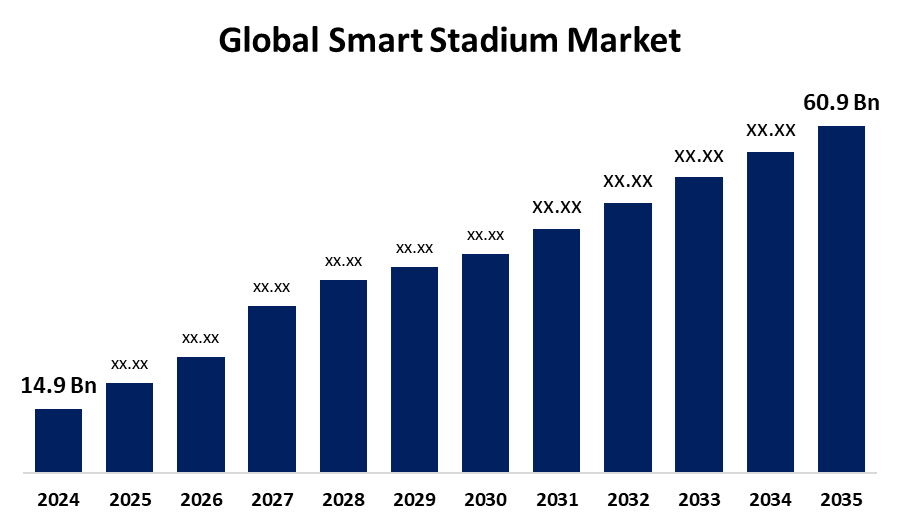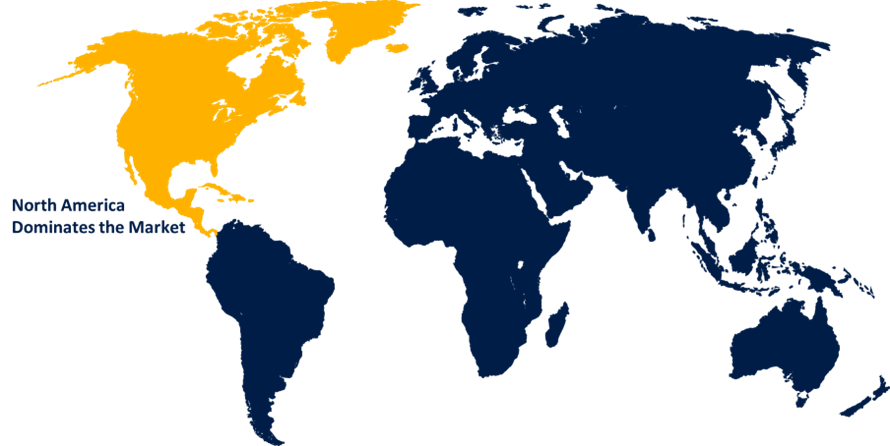Global Smart Stadium Market Size, Share, and COVID-19 Impact Analysis, By Offering (Infrastructure, Hardware, Software, and Services), By Installation (Retrofit and New Installation), By Deployment (On Premise and Cloud), and By Region (North America, Europe, Asia-Pacific, Latin America, Middle East, and Africa), Analysis and Forecast 2025 - 2035
Industry: Information & TechnologyGlobal Smart Stadium Market Insights Forecasts to 2035
- The Global Smart Stadium Market Size Was Estimated at USD 14.9 Billion in 2024
- The Market Size is Expected to Grow at a CAGR of around 13.65% from 2025 to 2035
- The Worldwide Smart Stadium Market Size is Expected to Reach USD 60.9 Billion By 2035
- Europe is Expected to Grow the fastest during the forecast period.

Get more details on this report -
The Global Smart Stadium Market Size was Worth Around USD 14.9 Billion in 2024 and is Predicted to Grow to Around USD 60.9 Billion By 2035 with a Compound Annual Growth Rate (CAGR) of 13.65% from 2025 and 2035. The reinventing of live sports by combining innovation, immersive fan experiences, and operational excellence. As demand and technology grow, global adoption is expected to expand dramatically.
Market Overview
The Smart Stadium Market Size refers to the cutting-edge sports complex that incorporates digital infrastructure, including sensors, Internet of Things devices, high-speed internet, and sophisticated data systems, to improve the fan experience, expedite operations, and increase income. To provide real-time services like seat upgrades, live game statistics, mobile food ordering, customized promotions, and traffic or parking updates, these stadiums make use of technology like 5G, Wi-Fi 6, mobile apps, and AI-powered analytics.
The using cutting-edge technologies to increase engagement and operational efficiency, smart stadiums are revolutionizing the sports experience. Digital tools and mobile apps improve fan interaction and provide new business opportunities. This digital transition was sped up by the COVID-19 pandemic, which placed a greater emphasis on crowd control and safety. Contactless services and optimum seating are examples of innovations that have become commonplace. Smart stadiums will keep changing to provide safer, more intelligent, and more engaging experiences as expectations change.
IoT sensors and devices are frequently employed for data collecting and real-time monitoring, improving the fan experience and operational efficiency. Additionally, the installation of 5G networks in stadiums offers fast internet access, opening the door for cutting-edge uses like augmented reality, live streaming, and real-time data analytics. Numerous sports leagues collaborate with tech firms to support the digital infrastructure and applications required to improve the spectator experience.
Report Coverage
This research report categorizes the smart stadium market based on various segments and regions, forecasts revenue growth, and analyzes trends in each submarket. The report analyses the key growth drivers, opportunities, and challenges influencing the smart stadium market. Recent market developments and competitive strategies such as expansion, type launch, development, partnership, merger, and acquisition have been included to draw the competitive landscape in the market. The report strategically identifies and profiles the key market players and analyses their core competencies in each sub-segment of the smart stadium market.
Global Smart Stadium Market Report Coverage
| Report Coverage | Details |
|---|---|
| Base Year: | 2024 |
| Market Size in 2024: | USD 14.9 Billion |
| Forecast Period: | 2025-2035 |
| Forecast Period CAGR 2025-2035 : | 13.65% |
| 2035 Value Projection: | USD 60.9 Billion |
| Historical Data for: | 2020-2023 |
| No. of Pages: | 245 |
| Tables, Charts & Figures: | 120 |
| Segments covered: | By Offering, By Installation, By Deployment, By Region. |
| Companies covered:: | Cisco Systems Inc., KORE Wireless Group, Fujitsu, Daktronics Inc., GP Smart Stadium, Extreme Networks, Inc., Huawei Technologies Co., Ltd., Belden Inc., IBM Corporation, Hewlett-Packard Enterprise Company, Intel Corporation, Corning Incorporated, Mapsted Corp., CommScope Holding Company Inc., NEC Corporation, Telefonaktiebolaget LM Ericsson, and Other Key Companies. |
| Pitfalls & Challenges: | COVID-19 Empact, Challenge, Future, Growth, & Analysis |
Get more details on this report -
Driving Factors
The need for immersive, technologically enabled spectator experiences and increased operational efficiency is propelling the smart stadium sector's rapid evolution. The way fans engage with live events is changing as a result of innovations like 5G, AR/VR, and IoT-enabled infrastructure. Intelligent features like real-time updates, dynamic ticketing, and customized services are becoming commonplace. Sustainability objectives are further supported by enhanced crowd control techniques and energy-efficient equipment. Smart stadiums are becoming a necessity for contemporary sporting arenas as technology develops and consumer expectations rise. It is anticipated that this momentum will further accelerate the expansion of the global market in the upcoming years.
Restraining Factors
It can be difficult for smaller organizations to afford the significant upfront and continuing costs associated with upgrading to smart stadiums. Digital system integration also makes systems more vulnerable to cyberattacks, necessitating expensive and robust security measures. Because so much personal data is collected, data privacy issues make operations even more difficult. Despite the obvious advantages, adoption may be slowed by these obstacles.
Market Segmentation
The smart stadium market share is classified into offering, installation, and deployment.
- The infrastructure segment dominated the market in 2024 and is projected to grow at a substantial CAGR during the forecast period.
Based on the offering, the smart stadium market is divided into infrastructure, hardware, software, and services. Among these, the infrastructure segment dominated the market in 2024 and is projected to grow at a substantial CAGR during the forecast period. The growth is driven by the growing need for cutting-edge technologies to improve operational effectiveness and fan experiences. IoT sensors, AI analytics, and 5G connections are being integrated into stadiums to improve energy efficiency, crowd control, and security. Additionally, investments in smart infrastructure solutions are being driven by the demand for better facility management and sustainable practices. Stadiums can now offer individualized services, real-time data analytics, and effective resource use through these developments, which propel segmental growth.
- The retrofit segment accounted for the largest share in 2024 and is anticipated to grow at the fastest CAGR during the forecast period.
Based on the installation, the smart stadium market is divided into retrofit and new installations. Among these, the retrofit segment accounted for the largest share in 2024 and is anticipated to grow at the fastest CAGR during the forecast period. The segmental growth is due to the increasing demand for affordable stadium modernization that avoids total reconstruction. To improve the fan experience and operational performance, many older venues are being updated with smart technologies, such as enhanced connections, sophisticated security systems, and energy-efficient solutions. Compared to developing new facilities, this method minimizes disruption and expense while enabling operators to satisfy the growing demands for sustainability and digital engagement while extending the life of their infrastructure.
- The on-premises segment accounted for the largest share in 2024 and is anticipated to grow at a significant CAGR during the forecast period.
Based on the deployment, the smart stadium market is divided into on-premises and cloud. Among these, the on-premises segment accounted for the largest share in 2024 and is anticipated to grow at a significant CAGR during the forecast period. The growth is attributed to high-speed connections and on-premise smart technology being adopted in modern stadiums due to the desire for better fan experiences. Both engagement and operational efficiency are increased by features like real-time data, smart seats, and HD screens. Personalized services and targeted advertising help revenue growth. The market for smart stadiums is still expanding quickly as IoT and data-driven solutions become more widespread.
Regional Segment Analysis of the Smart Stadium Market
- North America (U.S., Canada, Mexico)
- Europe (Germany, France, U.K., Italy, Spain, Rest of Europe)
- Asia-Pacific (China, Japan, India, Rest of APAC)
- South America (Brazil and the Rest of South America)
- The Middle East and Africa (UAE, South Africa, Rest of MEA)
North America is anticipated to hold the largest share of the smart stadium market over the predicted timeframe.

Get more details on this report -
North America is anticipated to hold the largest share of the smart stadium market over the predicted timeframe. The growing desire for improved digital experiences and fan interaction. To increase operational effectiveness and safety, stadiums are incorporating cutting-edge technology like IoT, 5G, and AI. Mobile ticketing, contactless payments, and smart seating solutions are becoming more and more popular since they are convenient and eliminate the need for physical touchpoints. Security, resource optimization, and crowd management are all commonly managed with real-time data analytics.
Europe is expected to grow at a rapid CAGR in the smart stadium market during the forecast period. The region's robust sports culture and technical innovation are the main drivers of its prosperity. Integrated technologies for digital signage, crowd control, and interactive fan experiences are being adopted by stadiums more frequently. Wi-Fi 6 and 5G are examples of advanced connectivity technologies that guarantee smooth digital interactions. AI-powered analytics enhance security procedures and maximize event operations.
Competitive Analysis:
The report offers the appropriate analysis of the key organizations/companies involved within the smart stadium market, along with a comparative evaluation primarily based on their type of offering, business overviews, geographic presence, enterprise strategies, segment market share, and SWOT analysis. The report also provides an elaborative analysis focusing on the current news and developments of the companies, which includes type development, innovations, joint ventures, partnerships, mergers & acquisitions, strategic alliances, and others. This allows for the evaluation of the overall competition within the market.
List of Key Companies
- Cisco Systems, Inc.
- KORE Wireless Group
- Fujitsu
- Daktronics, Inc.
- GP Smart Stadium
- Extreme Networks, Inc.
- Huawei Technologies Co., Ltd.
- Belden Inc.
- IBM Corporation
- Hewlett-Packard Enterprise Company
- Intel Corporation
- Corning Incorporated
- Mapsted Corp.
- CommScope Holding Company, Inc.
- NEC Corporation
- Telefonaktiebolaget LM Ericsson
- Others.
Key Target Audience
- Market Players
- Investors
- End-users
- Government Authorities
- Consulting And Research Firm
- Venture capitalists
- Value-Added Resellers (VARs)
Recent Development
- In February 2025, Barco's ClickShare worked with Neat to improve meeting room cooperation. The Neat Bar 2 and Neat Bar Pro have acquired ClickShare certification, allowing for simple wireless conferencing. This cooperation provides seamless end-to-end experiences for ClickShare and Neat clients, supporting Barco's commitment to improving professional environments.
Market Segment
This study forecasts revenue at global, regional, and country levels from 2020 to 2035. Spherical Insights has segmented the smart stadium market based on the below-mentioned segments:
Global Smart Stadium Market, By Offering
- Infrastructure
- Hardware
- Software
- Services
Global Smart Stadium Market, By Installation
- Retrofit
- New Installation
Global Smart Stadium Market, By Deployment
- On Premise
- Cloud
Global Smart Stadium Market, By Regional Analysis
- North America
- US
- Canada
- Mexico
- Europe
- Germany
- UK
- France
- Italy
- Spain
- Russia
- Rest of Europe
- Asia Pacific
- China
- Japan
- India
- South Korea
- Australia
- Rest of Asia Pacific
- South America
- Brazil
- Argentina
- Rest of South America
- Middle East & Africa
- UAE
- Saudi Arabia
- Qatar
- South Africa
- Rest of the Middle East & Africa
Frequently Asked Questions (FAQ)
-
1. What is the CAGR of the smart stadium market over the forecast period?The global smart stadium market is projected to expand at a CAGR of 13.65% during the forecast period.
-
2. What is the market size of the smart stadium market?The global smart stadium market size is expected to grow from USD 14.9 Billion in 2024 to USD 60.9 Billion by 2035, at a CAGR of 13.65% during the forecast period 2025-2035.
-
3. Which region holds the largest share of the smart stadium market?North America is anticipated to hold the largest share of the smart stadium market over the predicted timeframe.
Need help to buy this report?